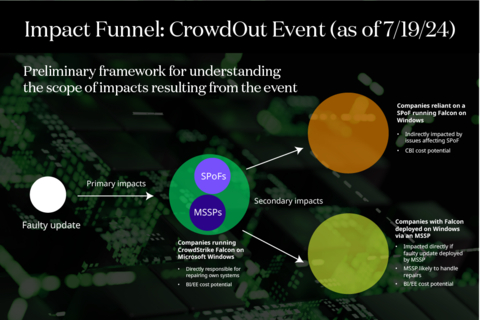CrowdStrike Fallout Underscores How Single Point of Failure Technologies Create Widespread Disruption, Says CyberCube
CrowdStrike Fallout Underscores How Single Point of Failure Technologies Create Widespread Disruption, Says CyberCube
LONDON--(BUSINESS WIRE)--The faulty CrowdStrike Falcon Sensor update and subsequent outage – the CrowdOut Event – underscore the potential for Single Point of Failure (SPoF) technology outages to impact the global digital economy. CyberCube is advising clients on how to use SPoF Intelligence to identify exposed insureds and estimate the exposure footprint of the event. SPoF Intelligence is the definitive source for analyzing a portfolio's digital supply chain, integrated with the industry's leading cyber model.
What Happened?
A global IT system outage was triggered by a faulty software update from CrowdStrike, causing widespread disruptions across various Windows operating system (OS) types. The issue originated from a defective kernel driver included in the update, which led to numerous systems crashing globally and displaying the “Blue Screen of Death” (BSoD).
The issue began with a CrowdStrike update that was intended to enhance security but inadvertently included a logic error in a configuration file. Invalid operations caused by the logic error led to the OS encountering conditions it cannot resolve. This resulted in system crashes, manifesting as the BSoD. The BSoD is a protective measure to prevent further damage to the OS by stopping all operations.
Who Is Impacted?
The faulty update affects companies using CrowdStrike’s Falcon software on machines running Windows OS, both desktop (including Windows 10 and 11) and Windows Server. These are the primary companies affected by the event. With its global position in cybersecurity, CrowdStrike’s own customer base includes many other organizations that CyberCube identifies as SPoFs. Companies relying on one of these SPoFs may be secondary victims of the event, even if they do not use CrowdStrike and Windows directly. Additionally, CrowdStrike Falcon is deployed by managed security service providers (MSSPs) on the networks of other – typically smaller – organizations they oversee. These organizations using such MSSPs are also secondary victims of the event. Notably, financial institutions, healthcare providers, and transportation networks have all experienced disruptions.
Applying the SPoF Intelligence tool to search for insureds that are dependent on CrowdStrike Falcon, shows it is likely that all users of the core components of the CrowdStrike Falcon platform in conjunction with Windows OS are impacted. Analysis of the count of companies exposed across CyberCube’s US Industry Exposure Database (IED) identifies large companies in Manufacturing, IT, Healthcare, and Financials as the most likely to be exposed. Examination of exposed limits shows an outsize exposure in the Aviation, Banking, and Retail sectors.
CyberCube has provided clients with a list of SPoFs that are dependent both on CrowdStrike Falcon and Windows OS. The outage affects various versions of Windows operating systems. This broad scope means that any organization or individual using these operating systems alongside CrowdStrike Falcon is at risk of experiencing system crashes and operational disruptions.
Catastrophic Loss Modeling
The primary impacts of the CrowdOut Event closely resemble two scenarios in CyberCube’s Portfolio Manager aggregation model. Modeling scenario classes 41 (operating system disruptions on endpoints) and 42 (operating system disruptions on servers) within CyberCube’s event catalog show the CrowdOut Event to be mainly a system failure or business interruption (BI) event.
Customers may experience secondary impacts by way of additional SPoFs that fall within this primary footprint. SPoFs for scenario classes 4, 9, 10, 11, and 18 (mainly related to financial services and payment system technologies) have been observed as users of CrowdStrike and Windows operating systems, exposing companies that rely on these SPoFs to possible contingent business interruption (CBI) outages.
What To Expect?
Affected organizations can expect a series of remediation and recovery efforts to take place immediately. Companies with the IT resources to handle large-scale incidents are expected to recover faster. There may be ongoing disruptions as companies implement patches and verify their systems' stability. Rolling back the update and applying patches requires specialized knowledge. For small and medium-sized companies, a lack of access to IT staff could delay the remediation process. Companies lacking robust contingency or IT backup plans could also face additional disruptions.
CyberCube Support
CyberCube's Cyber Aggregation Event Response Service (CAERS) has been activated as a result of the CrowdStrike event. CAERS provides up-to-date intelligence on major cyber catastrophes worldwide as they unfold to ensure CyberCube clients have the most relevant information. CyberCube will continue to monitor this developing event and provide support for customers in calculating the impact on their own cyber insurance portfolios.
About CyberCube
CyberCube is the leading provider of software-as-a-service cyber risk analytics to quantify cyber risk in financial terms. Driven by data and informed by insight, we have harnessed the power of artificial intelligence to supplement our multi-disciplinary team. Our clients rely on our solutions to make informed decisions about managing and transferring cyber risks. We unpack complex cyber threats into clear, actionable strategies, translating cyber risk into financial impact on businesses, markets, and society as a whole.
The CyberCube platform was established in 2015 within Symantec and now operates as a standalone company. Our models are built on an unparalleled ecosystem of data and validated by extensive model calibration, internally and externally. CyberCube is the leader in cyber risk quantification for the insurance industry, serving over 100 insurance institutions globally. The company’s investors include Forgepoint Capital, HSCM Bermuda and Morgan Stanley Tactical Value. For more information, please visit www.cybcube.com or email info@cybcube.com.
Contacts
Yvette Essen, Head of Content, Communications & Creative, yvettee@cybcube.com
